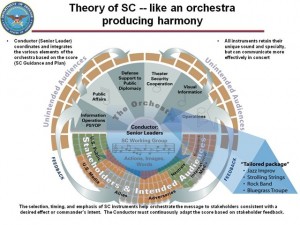The term “Strategic Communication” gets tossed around a lot and most of the time, I see it used by those in our field who want to give the impression that their plan is something larger than just a communications strategy. I’ve read many Strategic Communications plans that are nothing more than some analysis, a list of stakeholders, and some tactics directed at a communication objective. If going back several years, many would have called this a Communication Plan. So what differentiates a Strategic Communication Plan from just a Communication Plan?
What’s the Definition of SC?
The term Strategic Communications became popular in government and has evolved over the last 5-10 years within both the Department of State and Department of Defense. The Department of Defense currently defines SC as:
“Focused United States Government efforts to understand and engage key audiences to create, strengthen, or preserve conditions favorable for the advancement of United States Government interests, policies, and objectives through the use of coordinated programs, plans, themes, messages, and products synchronized with the actions of all instruments of national power.”
I think the definition needs some work, but the part that jumps out to me as being different is at the very end when it discusses the synchronization with the actions of all instrument of national power (i.e. Diplomacy, Information, Military, Economics). This means that communicators are getting into areas that they have traditionally not been involved in, and those that have not been involved in communications are having to get into communications.
Strategic Communication is a process that involves not only communicators, but players from all different aspects of an organization. It is a process because while the communicator may often times help facilitate that process, it is rarely ‘owned’ by any single department. As a Strategic Communication planner for the International Security Assistance Force (ISAF) in Kabul, we are attempting to synchronize and coordinate all the actions – to include kinetic and non-kinetic – in order to reach our objectives. If using the U.S. definition of SC, it would mean everything falling under diplomacy, information, military and economics.
There is no one person who possesses expertise in all of these areas, so the process occurs in the discussions and synchronization about what we are trying to achieve. It means that as a communicator – and as only one piece of the larger SC process – I have to try and get into the business of others more so that I can understand it while also attempting to get others to better understand the communication aspect.
For a non-government organization, this essentially would mean that an SC Plan would not be just about communications, otherwise it would be called a Communication Plan. A Strategic Communication plan should be a process, which involves all aspects of a company working together toward common goals. It would involve R&D, operations, management, legal, logistics, and any other department that makes up the company.
A better explanation of SC
The evolution of SC over the years has produced “little beyond the huge volume of PowerPoint slides, issue papers, and studies, with few actual measures taken to develop a synchronized, coordinated interagency national program.”[1] This is obviously speaking about SC from a DoD perspective, but the same could be said about the corporate perspective as well.
There are lots of articles and books written about Strategic Communications. I read as many of these articles as I can find, but most of them only involve the communication aspect. In my mind, this is nothing more than a re-branded Communication Plan, which we have done long before SC became the term-du-jour over the last decade.
The question that needs to first be asked is what is the difference between your Communications Plan and a Strategic Communications Plan? If your plan only involves communications and communicators, than it is probably a Communications Plan. The much harder SC route is to try and involve areas out of your lane of expertise, departments that don’t want to be synchronized, and ambiguous organizational goals that cross multiple parts of a company. If that process is identified in your plan, than in my mind we’re getting more towards Strategic Communications.
[1] William M. Darley, “The Missing Component of U.S. Strategic Communications,” Joint Force Quarterly, Issue 47 (2007), 109.
Image taken from U.S.Joint Forces Command ‘Commander’s Handbook for Strategic Communication and Communication Strategy’ Version 3.0, dated 24 June 2010.


2 Responses to Strategic Communications or just Communications?